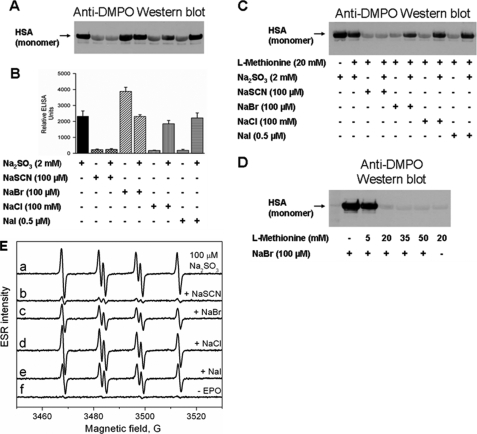FIGURE 6.
Effect of halides and pseudohalides on the formation of DMPO-HSA-derived radical nitrone adducts. A, Western blotting. B, ELISA. Reaction mixtures containing HSA (600 μm), Na2SO3 (2 mm), DMPO (1 mm), and H2O2 (100 μm) with and without the indicated concentrations of NaSCN, NaBr, NaCl, and NaI were initiated by EPO (1 μm). ELISA data presented are the means ± S.D. from three independent determinations using fresh preparations of all reaction components. C, Western blotting effect of halides and pseudohalides on the formation of DMPO-HSA-derived radical nitrone adducts in the presence of 20 mm methionine. D, concentration-dependent effect of methionine on the formation of DMPO-HSA-derived radical nitrone adducts in the absence of bisulfite. For Western blotting, reactions, including albumin (600 μm), NaBr (100 μm), DMPO (1 mm), H2O2 (100 μm), and methionine as indicated, were initiated with 1 μm EPO, and the mixtures were incubated for 1 h at 37 °C in 100 mm phosphate buffer (pH 7.4). Each lane contained 3.8 μg of HSA. E, effect of halides and pseudohalides on the formation of DMPO/·SO3− radical adduct. Spectrum a, reaction mixture containing Na2SO3 (100 μm), DMPO (100 mm), and H2O2 (100 μm) in 100 mm phosphate buffer, pH 7.4. After initiation with EPO (1 μm), the mixture was immediately placed into the flat cell. Na2SO3 (100 μm) was used for the remaining experiments. The spectrum was attenuated in the presence of 100 μm NaSCN (spectrum b), 100 μm NaBr (spectrum c), 100 mm NaCl (spectrum d), and 0.5 μm NaI (spectrum e). Control without EPO did not form DMPO/·SO3− radical adduct (spectrum f).

